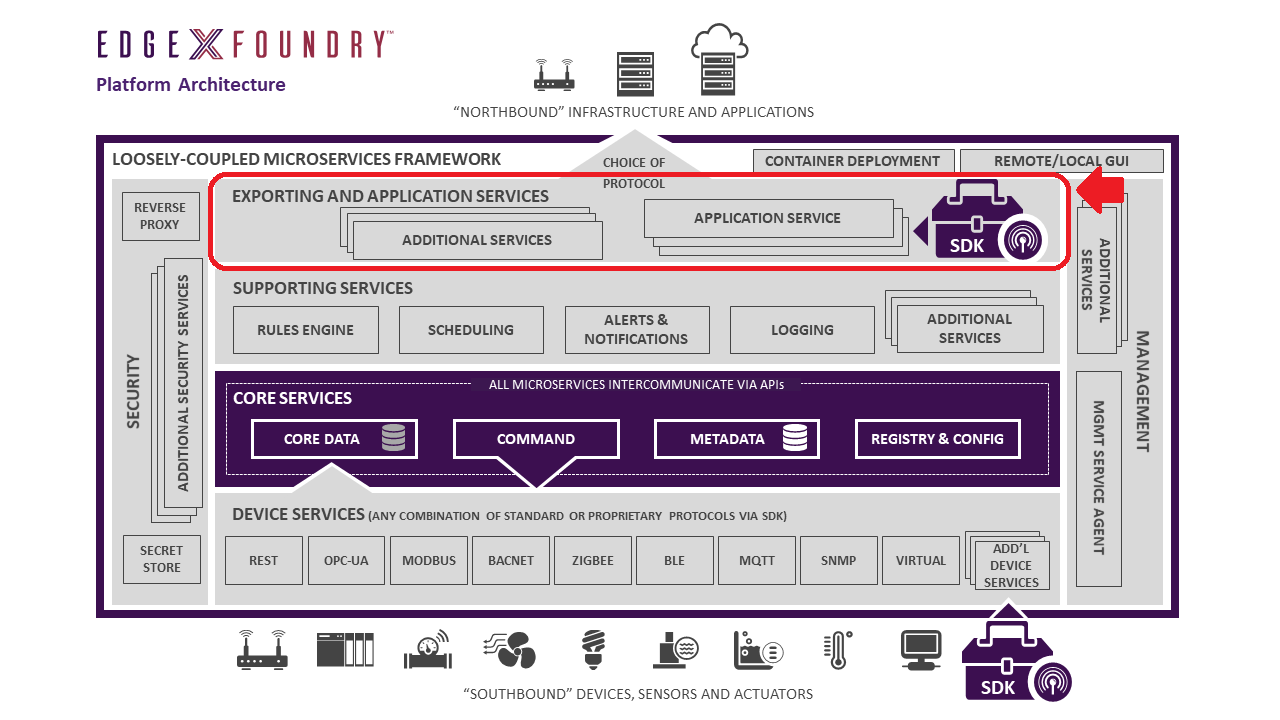Application Services

Application Services are a means to get data from EdgeX Foundry to external systems and process (be it analytics package, enterprise or on-prem application, cloud systems like Azure IoT, AWS IoT, or Google IoT Core, etc.). Application Services provide the means for data to be prepared (transformed, enriched, filtered, etc.) and groomed (formatted, compressed, encrypted, etc.) before being sent to an endpoint of choice. Endpoints supported out of the box today include HTTP and MQTT endpoints, but will include additional offerings in the future and could include a custom endpoints.
Note
Application Services has replaced Export Services
Application Services are based on the idea of a "Functions Pipeline". A functions pipeline is a collection of functions that process messages (in this case EdgeX event/reading messages) in the order that you've specified. The first function in a pipeline is a trigger. A trigger begins the functions pipeline execution. A trigger is something like a message landing in a watched message queue.

An Applications Functions Software Development Kit (or App Functions SDK) is available to help create Application Services. Currently the only SDK supported language is Golang, with the intention that community developed and supported SDKs will come in the future for other languages. It is currently available as a Golang module to remain operating system (OS) agnostic and to comply with the latest EdgeX guidelines on dependency management.
Any application built on top of the Application Functions SDK is considered an App Service. This SDK is provided to help build Application Services by assembling triggers, pre-existing functions and custom functions of your making into a pipeline.
Application Service Improvements
Providing an SDK that connects directly to a message bus by which Core Data events are published eliminates performance issues as well as allow the developers extra control on what happens with that data as soon as it is available. Furthermore, it emphasizes configuration over registration for consuming the data. The application services can be customized to a client's needs and thereby also removing the need for client registration.
Standard Functions
As mentioned, an Application Service is a function pipeline. The SDK provides some standard functions that can be used in a functions pipeline. In the future, additional functions will be provided "standard" or in other words provided with the SDK. Additionally, developers can implement their own custom functions and add those to their Application Service functions pipeline.

One of the most common use cases for working with data that comes from
Core Data is to filter data down to what is relevant for a given
application and to format it. To help facilitate this, four primary
functions ported over from the existing services today are included in
the SDK. The first is the DeviceNameFilter function which
will remove events that do not match the specified IDs and will cease
execution of the pipeline if no event matches. The second is the
ValueDescriptorFilter which exhibits the same behavior as
DeviceNameFilter except filtering event readings on Value Descriptor
instead of DeviceID. The third and fourth provided functions in the SDK
transform the data received to either XML or JSON by calling
XMLTransform or JSONTransform.
Typically, after filtering and transforming the data as needed,
exporting is the last step in a pipeline to ship the data where it needs
to go. There are two primary functions included in the SDK to help
facilitate this. The first is theHTTPPost function that will POST the provided data
to a specified endpoint, and the second is an MQTTSecretSend() function that will publish
the provided data to an MQTT Broker as specified in the configuration.
There are two primary triggers that have been included in the SDK that
initiate the start of the function pipeline. First is via a POST HTTP
Endpoint /api/v1/trigger with the EdgeX event data as the body.
Second is the MessageBus subscription with connection details as
specified in the configuration.
Finally, data may be sent back to the message bus or HTTP response by
calling .complete() on the context. If the trigger is HTTP, then it will
be an HTTP Response. If the trigger is MessageBus, then it will be
published to the configured host and topic.
Unsupported existing export service functions
Valid Event Check--The first component in the pipe and filter, before the copier (described in the previous section) is a filter that can be optionally turned on or off by configuration. This filter is a general purpose data checking filter which assesses the device- or sensor-provided Event, with associated Readings, and ensures the data conforms to the ValueDescriptor associated with the Readings.
- For example, if the data from a sensor is described by its metadata profile as adhering to a "Temperature" value descriptor of floating number type, with the value between -100° F and 200° F, but the data seen in the Event and Readings is not a floating point number, for example if the data in the reading is a word such as "cold," instead of a number, then the Event is rejected (no client receives the data) and no further processing is accomplished on the Event by the Export Distro service.